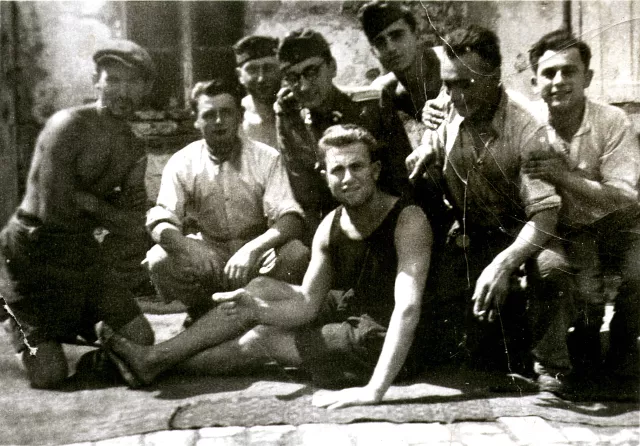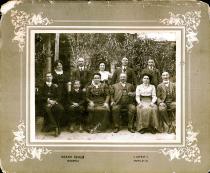Ferenc Szabados in forced labor
This picture was taken in 1943 in Hodmezovasarhely during work service. First from the left is Hermann Fischer, who settled in Australia. He a resident of Kolozsvar, but since the Hungarians annexed it back [see: second Vienna decision], he was called up for work service. Second from the left, I don’t recall his name, he was a member of the skeleton staff at the camp. The situation hadn’t gone so wild yet and in the beginning they treated us well. The first from the right was Tibor Kalan, he just died three or four years ago. All I know about him was that he lived on Rozsadomb. Then comes Laszlo Pollak, he’s also here. This was a boy from Szeged, he was the director of the Szeged congregation, he just died a year ago. The whole group ended up in Bor, except for me. Those who were commanded to go there, had nothing more to hope for. Those I mentioned in the picture were the lucky ones. Though they went to Bor, they struggled out successfully.
I was drafted into the work service on October 13, 1941 into the V/2 kmsz. company in Hodmezovasarhely. We got soldier’s uniforms, but they soon stuck a yellow armband on us, to differentiate that we were Jews, not fully-privileged Hungarian citizens. They took the uniform off of us later, at the request of headquarters. Then everybody was in civilian clothes. They left us the hat, but there was a national colored button on it, which they took off it, so we wouldn’t desecrate the Hungarian national colors. [The national guard ministry decreed in March of 1942 that the Jewish workservice should wear their own civilian clothes, and should sew a yellow armband on them, but in a lot of the groups the uniform had already been taken away by the end of 1941. Until the spring of 1942, there wasn’t general proscription of the yellow armband, but depending on the commander, this was also widespread. – ed.] I was put in the dispensary, in the sewing workshop. From that time, in November of 1941, they then took me to Korosmezo, in the Ukraine [this belonged to Hungary at that time, see: Lower Carpathian Invasion ] where we built tank traps and bridges. In the fall of 1942, (probably in September) we returned to Hodmezovasarhely.
There was a band of fascists living in Hodmezovasarhely. They wrote in newspaper articles that we didn’t work. We just hang around and molest Hungarian girls. They connected us to everything. The city had already emptied out so much, only a few of us remained with our yellow bands. They called us into the Brigade commander and said that we shouldn’t listen to the lieutenant colonel’s words. Don’t do anything for him, work for him, because we’ll be immediately on the front. Hardly two days passed before the lieutenant colonel called us in to sew a suit for his son. Well, now what do we do? We couldn’t say no. On top of that, next to our quarters was a house where Jews were living, and they had been taken away the night before. We sewed his son the suit that night. If we didn’t sew that suit, they really would have sent us to the front. The commander said we should sew a suit for his son, because he also did for us. That was all he let us know, that thanks to him we weren’t taken away, too. Now where was this great friendship coming from? He once asked me where I was from? I told him Szabolcs, and he also came from there. That word was enough for him to not have me taken to the front.
































